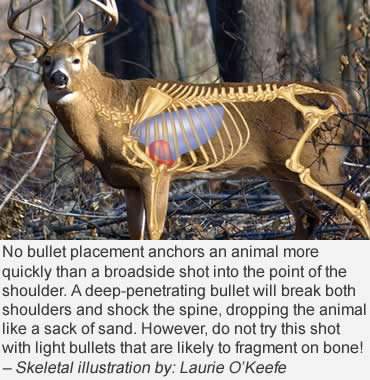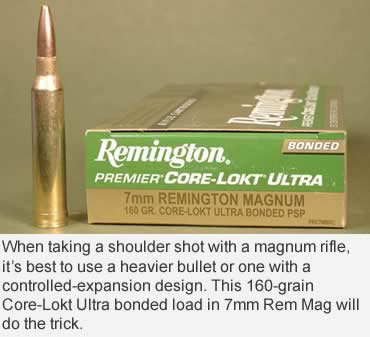Some shots are better than others for putting big game down quickly.
The fallacy that a rifle bullet will knock a deer off its hooves never seems to die. If a bullet did thump a deer that hard, the recoil from such a load would also kick the shooter out of his boots.
A bullet fired from a big-game rifle has about twice the momentum as a thrown baseball. Most baseball players have been hit by a wild pitch. Instead of knocking us off our feet, though, the impact just stings for a while.
What kills deer is the destruction of vital organs. An expanding bullet passing through the lungs or heart is a sure killer because no animal can live for more than a couple of minutes after that kind of damage. In that short time, however, the quarry may run 200 yards. To drop an animal in its tracks, a bullet must strike its central nervous system.
One of Newton’s laws of physics, paraphrased, is “for every force, there’s an equal but opposite force.” So if a bullet develops enough force to flatten a 150-pound deer, the opposing force would do the same thing to the hunter shooting it.
 Say a 150-grain bullet fired from a .30-06 rifle leaves the bore at 3,000 feet per second. If the rifle weighed the same as the bullet, it would go flying back at the same speed. We avoid this because an 8-pound .30-06 rifle is 373 times heavier than a 150-grain bullet.
Say a 150-grain bullet fired from a .30-06 rifle leaves the bore at 3,000 feet per second. If the rifle weighed the same as the bullet, it would go flying back at the same speed. We avoid this because an 8-pound .30-06 rifle is 373 times heavier than a 150-grain bullet.
To prove a hunting bullet cannot propel anything of substantial weight, I shot a 10-pound block of ballistic wax at 25 yards with a 250-grain Swift A-Frame bullet fired from a .338 Win Mag rifle. The bullet struck the wax with roughly 3,700 foot-pounds of energy. Despite absorbing all the bullet’s energy, the block remained in pretty much the same place and only jumped a little when the bullet hit it.
But what if the nearly 2 tons of energy did not go mostly toward bullet penetration, but was transferred to the target in one spot? At the range where I shot the block is a metal plate suspended by a chain at 100 yards. The plate probably weighs 35 pounds. The A-Frame bullet has a thick cross bar of jacket material in the forward third of the bullet, and doesn’t disintegrate when it hits the plate. The plate swung back maybe 3 inches when the bullet struck it with 3,400 foot-pounds of energy.
Bullet Placement
A hunter in a heavily pressured area needs to drop his deer quickly so it doesn’t run over the ridge and into the sights of another hunter. Whitetails in thickets also should be downed in a hurry because they can be hard to find if they run just 75 yards.
A broadside shot that penetrates both lungs is a quick killer. Aim a bit high on the lungs, and some of the bullet’s shock will impact the spine.
Last fall, my neighbor’s daughter, Emily, used her .257 Roberts with a Nosler 120-grain Partition to take a 5-point whitetail at 100 yards. The bullet went through the center of both lungs, and the deer ran only 20 yards.
She could have placed the bullet in several other spots if she’d wanted to drop the buck in its tracks. She could have aimed for the spinal column, but that’s like trying to hit a rope. Striking the vertebrae surrounding the spine would probably also fell the animal immediately. However, unless the bone was severely damaged, the deer might jump back up and run. Emily’s best bet would have been to shoot through the shoulders. This is a fairly large target, and without its front legs, a deer is going nowhere but down.
 A shot through the shoulders will likely pass in front of the lungs, so a finishing shot could be required. The shoulder shot also ruins meat. Last fall, my son shot a bull elk through the shoulders with a 150-grain Barnes Triple Shock bullet from his .30-06. That shot anchored the bull, but a finishing shot was required. When butchering the animal, I found about 10 pounds of the meat was unusable.
A shot through the shoulders will likely pass in front of the lungs, so a finishing shot could be required. The shoulder shot also ruins meat. Last fall, my son shot a bull elk through the shoulders with a 150-grain Barnes Triple Shock bullet from his .30-06. That shot anchored the bull, but a finishing shot was required. When butchering the animal, I found about 10 pounds of the meat was unusable.
The shoulder shot has always been my favorite on black bears. Breaking the shoulders, though, requires a perfectly broadside shot. You can make an equally sure shot to put down a bear when it’s standing slightly quartering toward or away from the gun. If it’s quartering toward you, place the bullet in the near shoulder, and it will continue on through the lungs. For a bear quartering away, aim for the rear of the lungs. The bullet will angle up through the lungs and take out the far shoulder.
Game from bears to antelope to elk react the same to the shoulder shot. It works well, not because of the fallacy that the bullet knocks them down, but because the bullet goes into the right spot.
This article was published in the September 2008 edition of Buckmasters GunHunter Magazine. Subscribe today to have GunHunter delivered to your home.